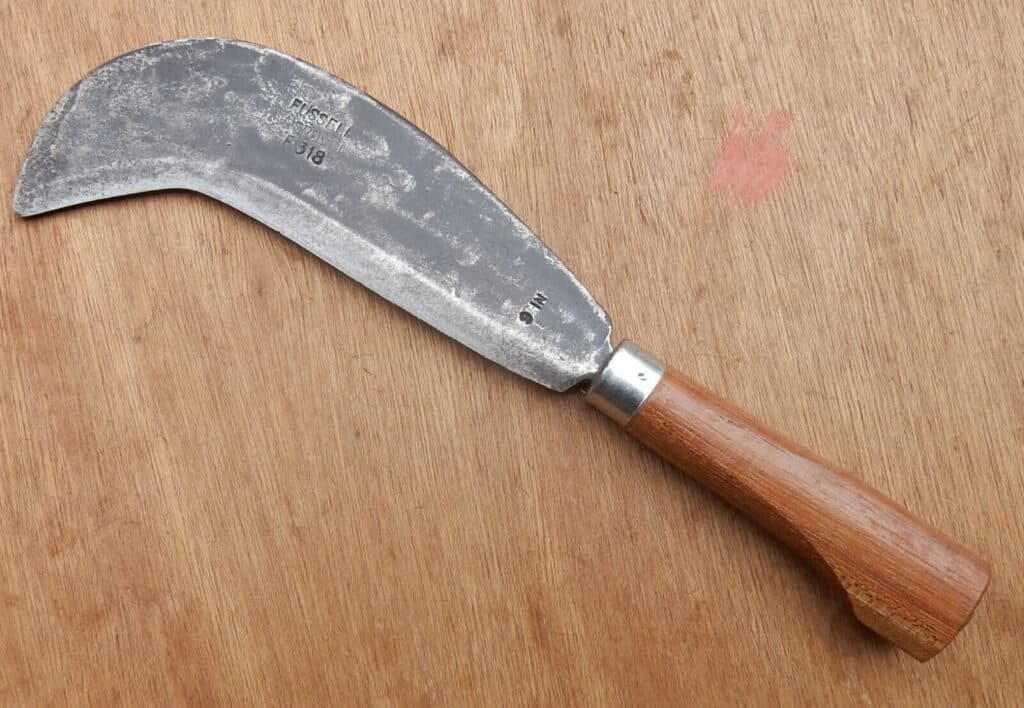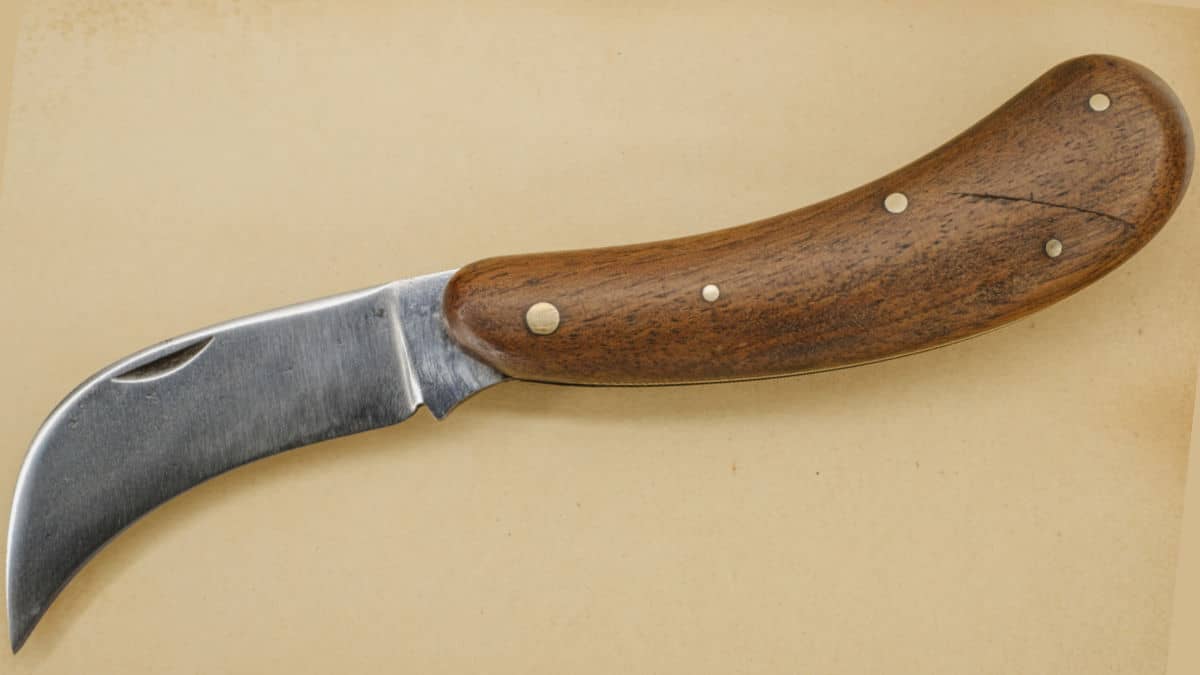When you visit a merchant by clicking a link on this site we may make a commission on anything you buy (at no additional cost to you). Affiliate programs and affiliations include, but are not limited to Amazon Associates and the eBay Partner Network.”
A billhook knife is a versatile cutting tool that has been widely used in agriculture and forestry for centuries. The distinctive curved blade and hooked end make it ideal for a variety of tasks, such as pruning shrubs, small trees, and cutting woody materials. As a traditional tool, it has seen many variations in design and function depending on the region and specific purpose it was intended for.
Primarily, the billhook knife is employed in countryside management practices, where precision cutting and shaping are essential. With the ability to cut, chop, and split, the billhook has become an indispensable part of traditional agriculture and forestry techniques. Additionally, its unique design enables landowners to efficiently maintain their land by clearing brush and shaping the landscape as needed.
Modern-day billhooks continue to maintain their relevance as a practical tool for land management tasks, showcasing their timeless effectiveness and adaptability. As people seek to preserve age-old traditions and explore sustainable land management methods, the billhook knife remains a useful and essential tool in the process.
Overview of Billhook Knife

The billhook knife, sometimes referred to as a billhook or reaping hook, is a versatile and unique cutting tool that predates contemporary farming equipment. It has been historically used for a variety of agricultural and forestry tasks, from pruning to clearing brush. This ancient tool is thought to have roots in the Bronze Age, which would make its use several thousand years old. However, it truly flourished in the Iron Age, when the use of iron and steel as tools became more commonplace.
The primary characteristics of a billhook knife are its distinctive carbon steel curved blade and hooked end. This design enables precise cutting, chopping, and splitting, making it an essential instrument in traditional countryside management. In addition to forestry and agriculture, it has also been employed for hedging and bark stripping. The versatility of the billhook knife has led to the development of regional variations, each adapted to cater to specific tasks and environments.
The durability of the billhook knife comes from its carbon steel construction. Carbon steel is an ideal material choice for these knives since it is both strong and able to retain a sharp edge, whether it be for pruning branches or harvesting crops. The hooked bill, or curved end, allows for easy manipulation of materials, such as guiding branches into the cutting zone or leveraging objects for splitting.
Despite the advancement of modern machinery and tools, the billhook knife still holds its place in the agricultural and forestry industries. Its ease of use and unique capabilities make it an indispensable tool for landowners and workers alike. The challenge of maintaining green spaces and conserving natural resources continues to evolve, and the billhook knife has adapted to meet those needs, remaining an enduring symbol of tradition and practicality.
Primary Uses of a Billhook Knife
A billhook knife is a versatile cutting tool widely used in agriculture and forestry for managing woody plants, such as small trees, shrubs, and branches. Its unique design, featuring a curved blade and hooked end, makes it suitable for various tasks, including pruning, clearing brush, and hedging1.
The billhook knife’s primary use is to cut through thick branches and vines. With its sharp, curved blade, it’s ideal for pruning small branches or shoots and trimming hedges. Farmers and woodsmen alike appreciate the billhook’s efficiency in tackling tasks that involve woody plants2.
Another significant application of billhooks is in coppicing3. This traditional woodland management technique involves removing the top part of a tree or shrub, allowing it to regrow with new, straight shoots. The billhook knife is perfect for this job, as its curved blade allows for precise control while cutting through saplings and branches.
Many billhooks are built with durability in mind. High carbon steel is often used in their construction, ensuring the blade’s sharpness and prolonging its useful life4. Some models also feature a stainless steel blade, providing additional corrosion resistance. The wooden handle paired with tang or socket joinery ensures a comfortable and secure grip, minimizing hand fatigue during extended use.
In certain regions, such as Yorkshire, UK, the billhook knife is known as a fascine knife or spar hook5. Local variations exist in design and functionality. For instance, some billhooks have a straight blade rather than the common curved shape, making them suitable for tasks that require a more linear edge. Furthermore, some billhooks have evolved to perform specific jobs, such as snedding or trimming side branches off a tree trunk6.
The billhook knife has an ancient history, with roots in iron and bronze age agricultural tools, including the coa and the spearhead7. This time-tested tool is essential for anyone working with woody plants, whether for agriculture or woodland management. Knowing how to maintain and sharpen the blade is crucial to ensure the billhook’s effectiveness in handling hardwood, grapevines, and other plant materials.
Types and Variations of Billhook Knives

Billhook knives have been a crucial tool in agriculture and forestry across various regions. They come in different shapes and sizes while maintaining a hooked blade and unique regional styles. High-carbon steel is usually preferred for the blade, which ensures durability and sharpness.
One of the most common types of billhooks is the English bill, used primarily for hedging and cutting branches. It possesses a curved, hooked blade that varies in lengths and weights depending on the geographical location. The English bill can further be subdivided into regional styles like Leicester, Warwickshire, Northern, and Midland types.
The fish tail billhook is another variation with a distinctive, widened end resembling a fish’s tail. This design enables better grip and control when working with thick brushwood and fascines. Fish tail billhooks are often utilized in constructing gabions and cannon emplacements.
Double-edged billhooks feature sharp cutting edges on both sides of the blade, which allows for versatile usage. This type of billhook is often employed in tasks such as fencing and clearing brushwood. High-quality double-edged billhooks were crafted by village smithies, following the principles of design that evolved over centuries.
The bagging hook, a cousin to the billhook knife, is a popular tool in regions like Pontypool/Monmouthshire, commonly used among the Southern group of hedgers. This hooked blade is shorter and more curved than the traditional English bill, ideal for tasks like trimming hedge tops.
In the West Country, particularly around Bristol, block hooks and Dutch hooks are commonly used. These variations feature a heavily curved, hooked blade and a more extended handle, allowing the user to dispatch vegetation with ease.
Renowned makers such as Imacasa have become synonymous with high-quality billhook knives. These knives exhibit unique features like the seamless blending of a machete and a billhook, ideal for cutting and clearing. Some billhooks have even inspired militaristic designs like the halberd, a combination of the billhook’s hooked blade and a pike.
The pioneer corps utilized billhooks with additional features like spikes or crooks attached to the backside of the blade, providing added utility for tasks like cutting through armor and as a weapon during battles.
In conclusion, billhook knives have been adapted into various types and styles throughout history and numerous geographical locations. With many distinct regional styles and added features, this versatile tool serves as a testimony to the ingenuity of its creators and the users who have relied on it for centuries.
How to Maintain and Sharpen a Billhook Knife

A billhook knife is a versatile cutting tool commonly used in agriculture and forestry for cutting woody materials like shrubs, small trees, and branches. It is traditionally made of high carbon steel or a combination of iron and bronze. This material ensures durability and sharpness while being resistant to wear. To maintain your billhook knife, consider the following steps:
First, always keep the knife clean. After use in the garden or outdoors, remove any dirt or debris clinging to the blade. Wipe it down with a cloth and some warm soapy water, then dry it thoroughly to prevent rust. To further protect the knife against rust, you can apply a light coat of oil on the blade, especially if you plan on storing it for an extended period.
When it comes to the wooden handle, try to keep it clean as well. If it becomes dirty or damaged, use sandpaper to remove any rough spots and finish it off with a coat of linseed oil to protect the wood. For knives with a tang construction, occasionally check the handle for any looseness and tighten the fasteners or bindings as needed.
A well-maintained billhook knife requires regular sharpening. Begin by inspecting the blade for any nicks or damage, filing down any larger imperfections with a metal file. To sharpen the blade, use a coarse whetstone or grinder, and be cautious not to overheat the metal. Next, move on to a finer grit whetstone to refine the edge. The sharpening process for a billhook knife can be a bit different from other knives due to its curved shape, so take your time and follow the curvature of the blade. Regularly honing the blade with a sharpening stone will keep it in optimal cutting condition.
Depending on the type of wood you’re working with, the cutting edge of a billhook knife can be used to effectively split saplings and branches. Ensure you’re practicing safe cutting techniques. If you need assistance in cutting, you can tap the back edge of the billhook knife with a wooden mallet or club to split and twist the wood. This technique can be beneficial when working with dense or tough materials like saplings.
Lastly, consider investing in a protective sheath made of leather or synthetic material to store your billhook knife when not in use. A sheath will not only protect the blade but also help prevent injuries when reaching for or handling the knife.
Additional Applications and Notable Cases
A billhook knife, also known as a hand bill, is a versatile cutting tool with a curved blade and a hooked end. It has been used for centuries in agriculture and forestry, making it an essential tool in traditional countryside management. One of its primary functions is cutting woody materials, such as shrubs and small trees, making it distinctly different from a sickle or a machete.
The strength of the billhook enables users to perform various tasks, ranging from pruning fruit trees like pears to clearing brush. Its unique blade design allows for precise cutting, chopping, and splitting. Moreover, its curved blade makes it more effective at trimming the excess growth of plants than other cutting tools like parangs or hedging bills.
Some additional applications of a billhook knife include:
- Hedging: Hedging bills are specifically designed for trimming and maintaining hedges. The billhook’s sharp curved blade allows for precise cutting, which is essential for maintaining a neat and tidy hedge.
- Broom hook: Often used in conjunction with brooms, the hooked end of a billhook can help dislodge stubborn debris, making cleaning more manageable.
- Talabot: A specialized billhook used mainly for pruning grapevines, the talabot ensures clean cuts and minimizes damage to the plant during vineyard maintenance.
- Reaping hook: The billhook’s hooked end can be used to effectively cut crops close to the stem, making it suitable for harvesting tasks, similar to a reaping hook.
Notable cases of billhook usage can be found throughout history and across various civilizations. In Europe, the billhook has long been a staple tool for clearing land and maintaining hedges. In Southeast Asia, billhook-like tools such as parangs are commonly used for both agricultural and survival purposes.
The ideal blade length of a billhook knife varies based on the intended application. Shorter blade lengths, for example, are better suited for precise tasks such as pruning, while longer blade lengths are more effective for clearing brush and cutting larger branches.
Conclusion
In conclusion, the billhook knife has proven its worth throughout history as a vital and versatile tool in agriculture and forestry. Its unique design, characterized by a curved blade and hooked end, allows for a range of uses, from pruning to clearing brush, making it an essential part of traditional countryside management. Despite modern technological advancements, the billhook knife maintains its relevance and significance, continuing to play a pivotal role in sustainable land management methods.
Regional variations and adaptations have given rise to a plethora of types and styles of billhook knives, each reflecting the specific needs and tasks of the area it originated from. High-carbon steel is the favored material for these blades due to its durability, sharpness, and resistance to wear, while its maintenance is a simple process of regular cleaning, sharpening, and care for the handle.
From the hedging bills used for maintaining tidy hedges to talabots for pruning grapevines, and reaping hooks for harvest tasks, the billhook knife has applications in many areas, a testament to its adaptability. Its role is not just limited to practical uses; it also stands as a symbol of tradition, craftsmanship, and human ingenuity. It is evident that the billhook knife’s longevity is a testament to its timeless effectiveness, and it will continue to be a valuable tool in agriculture and forestry for years to come.
Do Sheepsfoot Blades Have A Purpose? (Cuz They’re Ugly…)
Spetsnaz Machetes – Blades Of The Russian Special Forces
What Is The Actual Purpose Of A Spear Point Knife Blade?
CRKT CEO Review – Coolest, Most Worthless Knife Ever?
How Sharp Is A Scalpel? (Is It Sharper Than A Razor?)
Can You Shave With A Knife? (Yes, Here’s How)
When you visit a merchant by clicking a link on this site we may make a commission on anything you buy (at no additional cost to you). Affiliate programs and affiliations include, but are not limited to Amazon Associates and the eBay Partner Network.”







